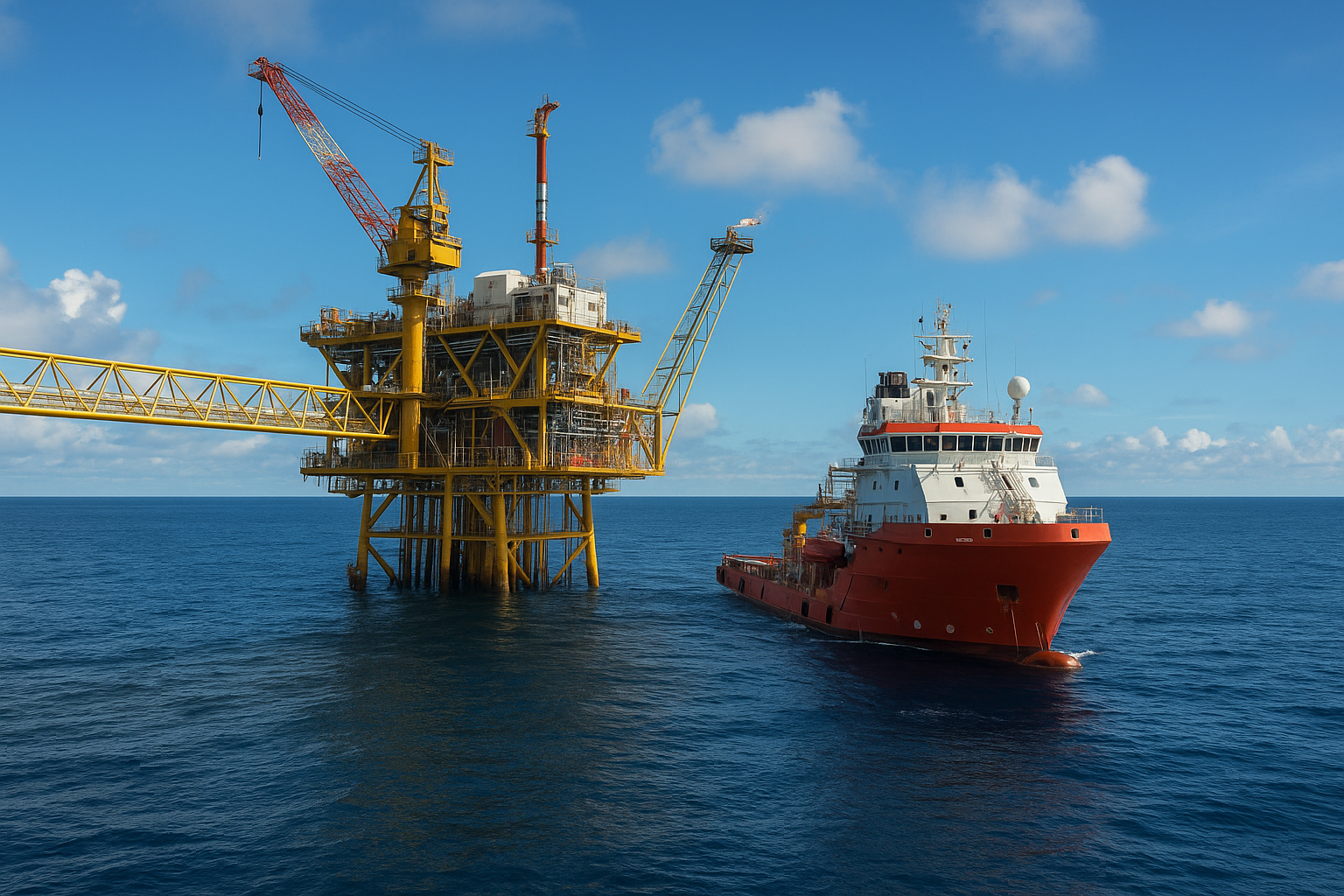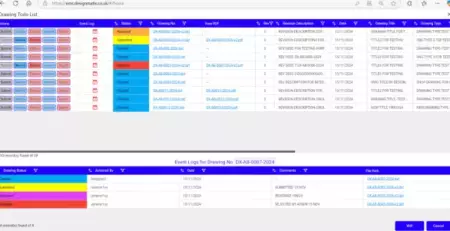
Offshore Engineering – Pushing the Boundaries of Innovation
designmatix.digital2025-11-05T02:36:35+00:00Oceans account for over 70% of the earth, yet much of it is waiting to experience direct human innovation. As mankind’s curiosity continue to push the boundaries of exploration and sustainability, offshore engineering stands at the forefront—bridging the gap between the known and the unknown. From tapping into the silence and power of deep sea to creating resilient floating infrastructures and enabling global connectivity through subsea networks,
Offshore Design Engineering in typically encompass range of engineering services offered in design, quality, fabrication and supporting on-site operations based on client specifications. An offshore engineer plays a pivotal role in the development of marine-based structures such as but not limited to off-shore rigs, Power modules, access & service platforms, crash frames, subsea platforms, pipelines or walkways. An Offshore Engineer ensures that the structures can withstand harsh marine environment while meeting stringent safety and quality standards.
In this article, we explain who offshore engineers are, how offshore engineering works, and what type of skills Off-shore engineers need to succeed in this growing field.
What’s Required to Become a Successful Offshore Engineer
An offshore engineer is trained in designing structures, components, and systems used in the offshore environment. Their focus is on structural integrity, stability, and protection under extreme marine environment. Provides consultation and engineering solutions for the design, analysis, installation, and inspection of offshore systems. The role supports projects across energy, marine, oil & gas sectors, ensuring compliance with international standards and client specifications.
Key responsibilities
- Design offshore platforms, jackets, and modules
- Review design compliance, specifications, calculations
- Model and simulate the structure using CAD and FEA equipment
- Following guidelines as per marine engineering codes and standards (ISO, API, DNV)
- Collaborate with cross-functions in engineering. E g: marine engineers, inspectors and mechanical contractors
- Assist in manufacturing, testing, and offshore installation support
Required skills
Area | Relevance to Offshore Design Engineering |
| Structural Engineering | Design a strong offshore base and topsides |
| CAD and 3D modeling | Use software like AutoCAD, SolidWorks, STAAD Pro |
| Offshore Codes | Apply ISO19901, API RP 2A, DNVGL-ST |
| Load & Stress Analysis | Compute wave pattern, wind, and current effects |
| Corrosion & Materials | Select long-life, corrosion-resistant materials |
| Safety & HSE Awareness | Design for safety in harsh offshore conditions |
Desirable Experience
Work experience in following products/areas may be preferred by companies looking for Off-shore Engineers:
- Fixed or floating platforms for Off-shore Oil rigs
- Offshore wind turbines
- Subsea systems (jumpers, manifolds, submersible shelters)
- Marine ports
- Floating Production Storage Units (FPSUs)
- Engineering, Procurement and Construction (EPC)
- Shipbuilding, rehabilitation, and MRO (Maintenance, repairs and overhaul) projects
- Disaster recovery infrastructure: Platforms or submersible structures
Demonstrated experience in following the Design Phases of an Offshore Project increases job prospects:
- Conceptual design
- Pre-FEED (Front End Engineering Design)
- Detailed Design & Engineering
- Architectural drawing & documentation
- Design verification
Qualifications
Academic requirements
- Bachelor’s degree in mechanical, civil or marine engineering
- Master’s in Offshore, Naval or Ocean Engineering
- Technical Training: Structural analysis, CAD, offshore geotechnics, Corrosion control
Relevant Certifications & Accreditations
| Certification Name | Issuing Authority | Country/Region |
| Chartered Engineer (CEng) | Engineering Council (UK) via IMechE, ICE, IStructE, etc. | Global |
| PE (Professional Engineer) | NCEES (USA) | US |
| Eur Ing | FEANI (Europe) | Europe |
| RPEQ | Board of Professional Engineers QLD (Australia) | Australia |
| CPEng | Engineers Australia | APAC/ANZ regions |
| NIP/SPSC | National Association of Coating Engineers | US |
Typical Career Progression
Level | Role |
| Graduate Design Engineer | Support modeling, drawing, and calculation |
| Junior Offshore Engineer | Assist in offshore structure design |
| Offshore Design Engineer | Guide the structure or component design |
| Senior Engineer | Manage large modules |
| Engineering Manager | Supervise a multidisciplinary offshore project |
Offshore Design Engineering in Action
i) Design challenges faced offshore
- Dynamic ocean loading: waves, windows, and current loads
- Saltwater Corrosion & fatigue: steel degradation over time compounded with salinity in marine (C5M) environment
- Biofouling – Marine growth effecting structural weight and thus maintenance requirements
- Remote location: restricted access and heavy logistics
- Harsh environment: high pressure and extreme temperature and humidity
- Stringent regulations: must meet international standards
ii) Technologies used
FEA Equipment: ANSYS, SACS,
CAD Software: AutoCAD, SolidWorks
3D Visualization: Navisworks, RhinoMarine
Project management: Primavera, MS Project
Future of Offshore Design Engineering
Eco-friendly energy expansion:
Offshore wind energy is increasing fast. Design Engineers are often required to create a deepwater wind turbine platform and support structure.
Automatic control & Digital Twins
Digital Engineers nowadays are using Artificial Intelligence (AI)-Powered models and real-time monitoring, via digital twin technology.
Renewable materials
Eco-friendly coating and sustainable materials are becoming standard in new offshore designs.
Professional demand
The demand for trained offshore engineers is rising in the energy, structural framework, and defence sectors globally.
Off Shore Engineering Roles :
Feature | Offshore Design Engineer | Offshore Engineer |
Role | Design & system for offshore use | Broad discipline covering offshore systems |
Focus Area | Structural design, protection codes, CAD equipment | Energy system, marine framework, innovation |
Industries | Oil, gas, wind | Energy, telecom, marine, defense |
Key Tools | AutoCAD, ANSYS, RhinoMarine | FEED Equipments, simulations, digital twins |
Career Path | Engineer.. Sr.Engineer…design lead… consultant | Technical expert- project manager- director |
Conclusion
Offshore Engineering is a key function – responsible for turning plans into a practical and code-compliant marine structures. With the rise of offshore wind, offshore solar farms complemented with digital transformation technologies, Off-shore engineer’s role has become more value-able than ever.
In summary, Off-shore engineering all about pioneering the technologies and systems to extend humanity’s access in to nature’s vastly unexplored environments. Offshore engineering is the foundation for engineering and innovation opportunities where land and limits no longer define possibility.
At Designmatix LTD, we believe in advancing this vision. Since in this article we also discussed what is an offshore engineer and what is offshore engineering, if you’re looking for a future in engineering that collaborates on innovation and sustainability than Offshore design engineering could be a promising and powerful career path worth exploring. As global energy industry transitions towards sustainable means of generation, the role of an offshore design engineer is more important than ever.
Frequently Asked Questions (FAQs)
The offshore design engineer designs offshore platforms, structures, and pipelines that can survive tough marine environments.
They mostly use AutoCAD, ANSYS, SACS, RhinoMarine, and SolidWorks.
Oil & gas, offshore wind energy, marine framework, and defense sector.
Yes, it offers global opportunities, handsome salaries, and long-term growth.
Ocean loading, corrosion, remote access, protection standards, and extreme circumstances.



